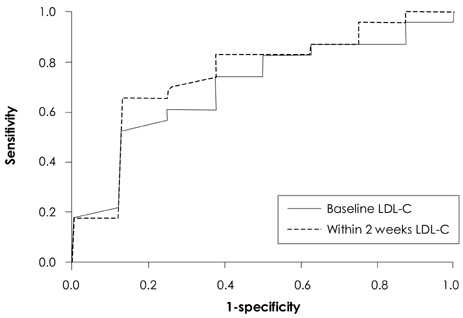Korean Circ J.
2008 Aug;38(8):419-424. 10.4070/kcj.2008.38.8.419.
The Early Treatment Gap of Dyslipidemia for Patients With Acute Myocardial Infarction
- Affiliations
-
- 1Department of Internal Medicine, College of Medicine, Chungbuk National University, Cheongju, Korea. drcorazon@hanmail.net
- KMID: 2225762
- DOI: http://doi.org/10.4070/kcj.2008.38.8.419
Abstract
-
BACKGROUND AND OBJECTIVES: A treatment gap for dyslipidemia can occur during the early phase of acute myocardial infarction (AMI) because the baseline low density lipoprotein-cholesterol (LDL-C) level during this period rapidly decreases physiologically.
SUBJECTS AND METHODS
We retrospectively reviewed the medical records of the patients who were admitted with AMI from December 2004 to July 2007 and their baseline LDL-C levels were less than 100 mg/dL. We analyzed the baseline lipid profiles and its serial changes in these patients. The initial LDL-C value, which can be expected to increase to over 100 mg/dL of LDL-C after discharge, was estimated statistically.
RESULTS
Among the 298 AMI patients, 94 (31.5%) patients showed a LDL-C level below 100 mg/dL. The LDL-C level increases between baseline and within 2 weeks, 2-6 weeks and 6 weeks after discharge were 11.8+/-22.5, 24.4+/-23.8 and 26.6+/-16.6 mg/dL, respectively. We made a receiver operating characteristics (ROC) curve of the LDL-C level at baseline and within 2 weeks after discharge for predicting the increment of the LDL-C level. Using the cutoff value 74 mg/dL for the initial LDL-C level, the sensitivity and specificity were 83% and 50%, respectively. With using an 81 mg/dL cutoff value at 2 weeks, the sensitivity and specificity were 83% and 62%, respectively.
CONCLUSION
A significant portion of AMI patients with an LDL-C level less than 100 mg/dL and who were not prescribed statin in the early phase of infarction showed an elevated LDL-C level over 100 mg/dL at 2 weeks after the infarction. The early administration of statin should be considered for treating an LDL-C=74 mg/dL during the initial period of AMI or an LDL-C=81 mg/dL at 2 weeks after AMI because their LDL-C level will increase to over 100 mg/dL during the subsequent follow-up period.
Keyword
MeSH Terms
Figure
Reference
-
1. Jun JE. Cholesterol lowering therapy in coronary artery disease. Korean Circ J. 2001. 31:849–856.2. Scandinavian Simvastatin Survival Study. Randomized trial of cholesterol lowering in 4,444 patients with coronary heart disease. Lancet. 1994. 344:1383–1389.3. Pfeffer MA, Sack FM, Moye LA, et al. Influence of baseline lipids on effectiveness of pravastatin in the CARE trial. J Am Coll Cardiol. 1999. 33:125–130.4. Schwartz GG, Olsson AG, Ezekowitz MD, et al. Effects of atorvastatin on early recurrent ischemic events in acute coronary syndromes: a randomized controlled trial. JAMA. 2001. 285:1711–1718.5. Ballantyne CM. Current and future aims of lipid-lowering therapy: changing paradigms and lessons from the heart protection study on standards of efficacy and safety. Am J Cardiol. 2003. 92:3K–9K.6. Expert Panel on Detection, Evaluation, and Treatment of High Blood Cholesterol in Adults. Executive Summary of the Third Report of the National Cholesterol Education Program (NCEP) Expert Panel on Detection, Evaluation, and Treatment of High Blood Cholesterol in Adult. JAMA. 2001. 285:2486–2497.7. Grundy SM, Cleeman JI, Merz CN, et al. Implications of recent clinical trials for the National Cholesterol Education Program Adult Treatment Panel III guidelines. Circulation. 2004. 110:227–239.8. Stenestrand U, Wallentin L. Early statin treatment following acute myocardial infarction and 1-year survival. JAMA. 2001. 285:430–436.9. Nagashima M, Koyanagi R, Kasanuki H, et al. Effect of early statin treatment at standard doses on long-term clinical outcomes in patients with acute myocardial infarction (the Heart Institute of Japan, Department of Cardiology Statin Evaluation Program). Am J Cardiol. 2007. 99:1523–1528.10. Samaha LA. The American Heart Association get with the guideline program. Am Heart J. 2004. 148:5 Suppl. S46–S48.11. Mehta RH, Montoye CK, Gallogly M, et al. Improving quality of care for acute myocardial infarction. JAMA. 2002. 287:1269–1276.12. Rosenson RS. Myocardial injury: the acute phase response and lipoprotein metabolism. J Am Coll Cardiol. 1993. 22:933–940.13. Cannon CP, Braunwald E, McCabe CH, et al. Intensive versus moderate lipid lowering with statins after acute coronary syndromes. N Engl J med. 2004. 350:1495–1504.14. Kim HS. Treatment guideline of dyslipidemia: update in 2006. The Korean J Med. 2006. 71:S703–S712.15. Aronow HD, Topol EJ, Roe MT, et al. Effect of lipid-lowering therapy on early mortality after acute coronary syndromes: an observational study. Lancet. 2001. 357:1063–1068.16. Sung JD, Kim SH, Kim YD, et al. Ten centers' study on the present state of treatment for hypercholesterolemia in patients with coronary artery disease. Korean J Med. 2005. 69:371–378.17. Kim SH, Park JS, Zo JH, Kim MA, Kim HS. Treatment gap in the management of hypercholesterolemia in Korea: return on expenditure achieved for lipid therapy (REALITY). Korean Circ J. 2006. 36:593–599.18. Fyfe T, Cochran KM, Baxter RH, Booth EM. Plasma-lipid changes after myocardial infarction. Lancet. 1971. 2:997–1001.
- Full Text Links
- Actions
-
Cited
- CITED
-
- Close
- Share
- Similar articles
-
- Serum Myoglobin in the Early Phase of Acute Myocardial Infarction
- Invasive Treatment of Acute Myocardial Infarction: What is the Optimal Therapy for Acute Myocardial Infarction?
- Primary Coronary Stenting as a Successful Treatment of Acute Myocardial
- Can time delay be shortened in the treatment of acute myocardial infarction?: Experience from Korea acute myocardial infarction registry
- A Case of Polycythemia Vera Presenting as an ST-Elevation Myocardial Infarction



